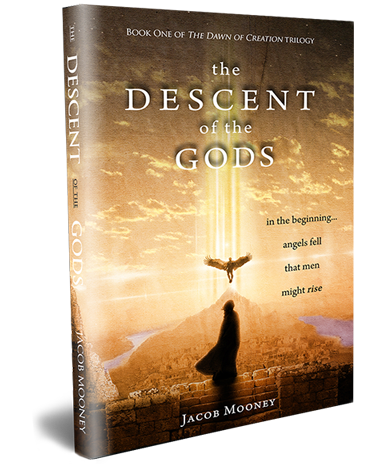
Date: circa 200 BC
Earliest Manuscripts: Dead Sea Scrolls (4Q203, 1Q23, 2Q26, 4Q530–532, 6Q8)
Perspective: Angelic interpretation
The Book of Giants is one of the most fascinating—and fragmentary—texts from the ancient Jewish world. Associated with the Book of Enoch, it offers a rare glimpse into the world before the Flood from the perspective of the Nephilim, the hybrid offspring of angels and human women.
While Genesis 6:1–4 only hints at the corruption brought by the “sons of God,” the Book of Giants expands that story dramatically. It zooms in on the giants themselves—their violent deeds, disturbing dreams, and desperate attempts to seek mercy through Enoch.
Though the full text is lost to history, what remains powerfully echoes the ancient Jewish concern over divine rebellion and the resulting human ruin.
The Text’s Origins and Connection to Enoch
The Book of Giants appears to have been composed in Aramaic and circulated among Jewish communities before the 2nd century BC. Manuscripts of the work were uncovered among the Dead Sea Scrolls, confirming that it held a place of significance in the Qumran sect’s theology.
Like the Book of Enoch, Giants is not part of the biblical canon in most traditions, though it is clearly built upon the Enochic tradition. In fact, it retells and elaborates on events summarized in Enoch 6–16—especially the sin of the Watchers (fallen angels) and the doom of their hybrid children.
Manichaean versions of the text later emerged, confirming that the story’s influence extended into multiple religious systems.
What the Book Says
The narrative focuses on the aftermath of the Watchers’ rebellion. Rather than spotlighting the angels, it centers on their monstrous children—giants with names like Ohya, Hahya, and even Gilgamesh (a name borrowed from Babylonian legend). These beings are depicted as mighty, yet increasingly disturbed.
The giants commit violence, pervert creation, and engage in miscegenation—mixing not only with humans but possibly animals, as suggested in some fragments. Their monstrous deeds corrupt the earth and provoke divine judgment.
But the text also humanizes them in a way: they experience fear, confusion, and longing for mercy. They suffer disturbing dreams, likely foretelling the coming Flood. They seek out Enoch—the righteous scribe and mediator between heaven and earth—pleading with him to intercede.
Key Themes from the Fragments
- Corruption of Creation: The giants “defiled” the earth, bred monsters, and engaged in unnatural unions. (4Q531 Frag. 2)
- Fear of Judgment: Dreams of floods and uprooted trees trouble the giants, pointing toward imminent destruction. (2Q26; 6Q8)
- Divine Warnings: Enoch sends back messages from God warning of a coming flood and calling for repentance. (4Q530 Frag. 2)
- Gilgamesh Connection: The inclusion of Gilgamesh reveals cultural crossover and mythic resonance with ancient Mesopotamian literature.
Selected Quotes
“They defiled [the earth]… they begot giants and monsters… the earth was corrupted… and they were seeking to devour many.”
— 4Q531 Frag. 2
“They drenched the tablet in the water… when it emerged, all but three names had been washed away.”
— 2Q26 (A dream likely symbolizing Noah’s survival)
“Let it be known to you… a great flood… will destroy all living things… loosen the bonds binding you to evil and pray.”
— 4Q530 Frag. 2 (Enoch’s message to the Watchers and giants)
Literary and Theological Significance
The Book of Giants reflects a sophisticated expansion of Genesis 6, highlighting themes of divine justice, angelic rebellion, and human vulnerability. It reveals a Jewish imagination deeply engaged with questions of cosmic order and moral boundaries.
It also showcases how early Jewish writers reinterpreted biblical stories using apocalyptic and mythological elements. The presence of Gilgamesh and symbolic dreams connects the Giants narrative with broader ancient Near Eastern thought.
From a New Testament perspective, Jude 6 and 2 Peter 2:4 allude to angels who sinned and are kept in chains until judgment—a likely reference to the same Enochic-Watcher tradition that Giants elaborates on.
Why the Book Was Not Canonized
Despite its popularity among some Second Temple communities, The Book of Giants was not included in the Hebrew Bible or New Testament canon. Several reasons include:
- Pseudepigraphic Authorship: The text claims to be related to Enoch, but was clearly written centuries later.
- Mythological Complexity: Its supernatural themes and blend with Near Eastern myths (like Gilgamesh) may have seemed too speculative.
- Fragmentary Nature: Unlike 1 Enoch, which has a continuous narrative, Giants survives only in fragments, making its theology harder to assess.
Why It Still Matters
Even if not canonical, the Book of Giants is vital for understanding the religious imagination of ancient Judaism. It clarifies how certain Jewish groups viewed Genesis 6:1–4—not as a vague note about angels, but as a serious warning about cosmic rebellion and its effects on human history.
This worldview influenced early Christians, especially those who wrestled with divine judgment, spiritual warfare, and apocalyptic expectations.
Explore More
- Dead Sea Scrolls Version of The Book of Giants (gnosis.org)
- Manichaean Version Translated by W. B. Henning (sacred-texts.com)
- The Dead Sea Scrolls: A New Translation by Wise, Abegg Jr., and Cook (Internet Archive)
Conclusion
The Book of Giants is a lost window into how ancient Jews—and later sects—processed the mystery of Genesis 6. Though not Scripture, it captures a powerful drama of rebellion, warning, and the longing for redemption.
Through Enoch, the giants seek mercy. But judgment still comes. The lesson is ancient, but enduring: divine justice is sure, and human corruption has consequences. Yet even in fragments, the ancient voices still call out—not just for understanding, but for hope.






